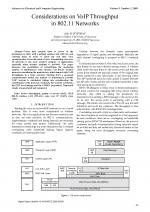| 3/2009 - 9 |
Considerations on VoIP Throughput in 802.11 NetworksPOTORAC, A. D. |
| Extra paper information in |
| Click to see author's profile in |
| Download PDF |
Author keywords
throughput, quality of service (QoS), IEEE 802.22 wireless LAN (WLAN), voice over IP (VoIP), voice codec
References keywords
networks(4)
Blue keywords are present in both the references section and the paper title.
About this article
Date of Publication: 2009-10-26
Volume 9, Issue 3, Year 2009, On page(s): 45 - 50
ISSN: 1582-7445, e-ISSN: 1844-7600
Digital Object Identifier: 10.4316/AECE.2009.03009
Web of Science Accession Number: 000271872000009
SCOPUS ID: 77954738959
Abstract
Voice data packets have to arrive at the destination in time, with a defined cadence and with low and constant delay in order to allow the real time voice reconstruction. From this point of view, transmitting voice over IP networks is the most sensitive category of applications, especially when wireless medium is involved. The paper discusses the possibilities of transmitting the maximum number of simultaneous voice streams over 802.11 wireless networks considering the main factors which impact with VoIP throughput, in a basic scenario. Starting from a proposed communication model, the number of simultaneous possible VoIP sessions is calculated, taking into consideration the contribution of the protocol overheads, the security overheads, the PHY level timings and the CODEC proprieties. Numerical results are generated and compared. |
| References | | | Cited By |
Web of Science® Times Cited: 5 [View]
View record in Web of Science® [View]
View Related Records® [View]
Updated today
SCOPUS® Times Cited: 10
View record in SCOPUS® [Free preview]
View citations in SCOPUS® [Free preview]
[1] An approach of video VoIP communications using emulated network bandwidth control environment, Balan, Doru, Potorac, Alin, ISSCS 2011 - International Symposium on Signals, Circuits and Systems, ISBN 978-1-61284-944-7, 2011.
Digital Object Identifier: 10.1109/ISSCS.2011.5978704 [CrossRef]
[2] Traffic shaping and traffic policing impacts on aggregate traffic behaviour in high speed networks, Daniel-Simion, Daian, Dan-Horia, Giura, 2011 6th IEEE International Symposium on Applied Computational Intelligence and Informatics (SACI), ISBN 978-1-4244-9108-7, 2011.
Digital Object Identifier: 10.1109/SACI.2011.5873048 [CrossRef]
[3] Use of delay distributions from emulated network environment for video VoIP services optimization, Balan, Doru, Potorac, Alin, 2011 RoEduNet International Conference 10th Edition: Networking in Education and Research, ISBN 978-1-4577-1233-3, 2011.
Digital Object Identifier: 10.1109/RoEduNet.2011.5993699 [CrossRef]
[4] Efficiency optimization under variable packet error rate for wireless LAN, Butt, Arooj Mobasher, Nasir, Ali, 2017 International Symposium on Wireless Systems and Networks (ISWSN), ISBN 978-1-5386-1556-0, 2017.
Digital Object Identifier: 10.1109/ISWSN.2017.8250031 [CrossRef]
[5] Load Profile Identification using Independent Component Analysis, Bobric, Elena Crenguta, Irimia, Daniela, 2019 International Conference on Electromechanical and Energy Systems (SIELMEN), ISBN 978-1-7281-4011-7, 2019.
Digital Object Identifier: 10.1109/SIELMEN.2019.8905826 [CrossRef]
Disclaimer: All information displayed above was retrieved by using remote connections to respective databases. For the best user experience, we update all data by using background processes, and use caches in order to reduce the load on the servers we retrieve the information from. As we have no control on the availability of the database servers and sometimes the Internet connectivity may be affected, we do not guarantee the information is correct or complete. For the most accurate data, please always consult the database sites directly. Some external links require authentication or an institutional subscription.
Web of Science® is a registered trademark of Clarivate Analytics, Scopus® is a registered trademark of Elsevier B.V., other product names, company names, brand names, trademarks and logos are the property of their respective owners.
Faculty of Electrical Engineering and Computer Science
Stefan cel Mare University of Suceava, Romania
All rights reserved: Advances in Electrical and Computer Engineering is a registered trademark of the Stefan cel Mare University of Suceava. No part of this publication may be reproduced, stored in a retrieval system, photocopied, recorded or archived, without the written permission from the Editor. When authors submit their papers for publication, they agree that the copyright for their article be transferred to the Faculty of Electrical Engineering and Computer Science, Stefan cel Mare University of Suceava, Romania, if and only if the articles are accepted for publication. The copyright covers the exclusive rights to reproduce and distribute the article, including reprints and translations.
Permission for other use: The copyright owner's consent does not extend to copying for general distribution, for promotion, for creating new works, or for resale. Specific written permission must be obtained from the Editor for such copying. Direct linking to files hosted on this website is strictly prohibited.
Disclaimer: Whilst every effort is made by the publishers and editorial board to see that no inaccurate or misleading data, opinions or statements appear in this journal, they wish to make it clear that all information and opinions formulated in the articles, as well as linguistic accuracy, are the sole responsibility of the author.



